BM627 Managing Innovation: TESCO's Strategy in the Retail Business
VerifiedAdded on 2023/06/10
|15
|4814
|449
Report
AI Summary
This report examines innovation practices in the retail industry, focusing on TESCO's strategies. It discusses the impact of COVID-19 on consumer behavior and the shift towards omnichannel approaches. The report outlines TESCO's current innovation implementations, such as expanding product lines and technology-based solutions like self-checkout systems and club cards. It identifies future innovation requirements for TESCO in 2022, including virtual and augmented reality, omnichannel commerce, customization, and faster delivery. Furthermore, the report explores TESCO's future innovation capabilities, emphasizing the importance of technology adoption, customer experience enhancement, and adapting to emerging retail trends. The analysis provides insights into how TESCO can maintain a competitive edge by embracing digitalization, personalization, and optimizing customer communication channels.

BM627
Managing Innovation
in Business
Managing Innovation
in Business
Secure Best Marks with AI Grader
Need help grading? Try our AI Grader for instant feedback on your assignments.
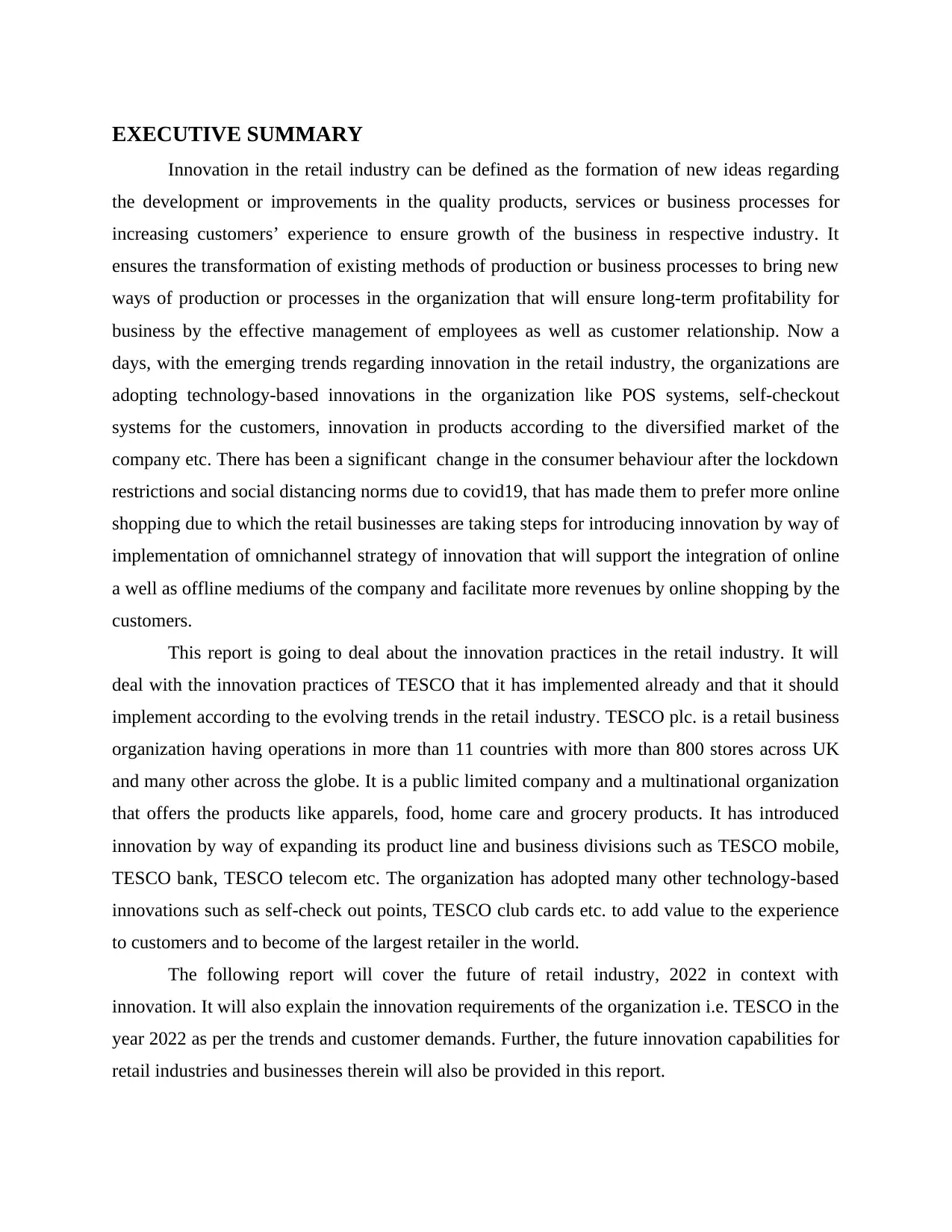
EXECUTIVE SUMMARY
Innovation in the retail industry can be defined as the formation of new ideas regarding
the development or improvements in the quality products, services or business processes for
increasing customers’ experience to ensure growth of the business in respective industry. It
ensures the transformation of existing methods of production or business processes to bring new
ways of production or processes in the organization that will ensure long-term profitability for
business by the effective management of employees as well as customer relationship. Now a
days, with the emerging trends regarding innovation in the retail industry, the organizations are
adopting technology-based innovations in the organization like POS systems, self-checkout
systems for the customers, innovation in products according to the diversified market of the
company etc. There has been a significant change in the consumer behaviour after the lockdown
restrictions and social distancing norms due to covid19, that has made them to prefer more online
shopping due to which the retail businesses are taking steps for introducing innovation by way of
implementation of omnichannel strategy of innovation that will support the integration of online
a well as offline mediums of the company and facilitate more revenues by online shopping by the
customers.
This report is going to deal about the innovation practices in the retail industry. It will
deal with the innovation practices of TESCO that it has implemented already and that it should
implement according to the evolving trends in the retail industry. TESCO plc. is a retail business
organization having operations in more than 11 countries with more than 800 stores across UK
and many other across the globe. It is a public limited company and a multinational organization
that offers the products like apparels, food, home care and grocery products. It has introduced
innovation by way of expanding its product line and business divisions such as TESCO mobile,
TESCO bank, TESCO telecom etc. The organization has adopted many other technology-based
innovations such as self-check out points, TESCO club cards etc. to add value to the experience
to customers and to become of the largest retailer in the world.
The following report will cover the future of retail industry, 2022 in context with
innovation. It will also explain the innovation requirements of the organization i.e. TESCO in the
year 2022 as per the trends and customer demands. Further, the future innovation capabilities for
retail industries and businesses therein will also be provided in this report.
Innovation in the retail industry can be defined as the formation of new ideas regarding
the development or improvements in the quality products, services or business processes for
increasing customers’ experience to ensure growth of the business in respective industry. It
ensures the transformation of existing methods of production or business processes to bring new
ways of production or processes in the organization that will ensure long-term profitability for
business by the effective management of employees as well as customer relationship. Now a
days, with the emerging trends regarding innovation in the retail industry, the organizations are
adopting technology-based innovations in the organization like POS systems, self-checkout
systems for the customers, innovation in products according to the diversified market of the
company etc. There has been a significant change in the consumer behaviour after the lockdown
restrictions and social distancing norms due to covid19, that has made them to prefer more online
shopping due to which the retail businesses are taking steps for introducing innovation by way of
implementation of omnichannel strategy of innovation that will support the integration of online
a well as offline mediums of the company and facilitate more revenues by online shopping by the
customers.
This report is going to deal about the innovation practices in the retail industry. It will
deal with the innovation practices of TESCO that it has implemented already and that it should
implement according to the evolving trends in the retail industry. TESCO plc. is a retail business
organization having operations in more than 11 countries with more than 800 stores across UK
and many other across the globe. It is a public limited company and a multinational organization
that offers the products like apparels, food, home care and grocery products. It has introduced
innovation by way of expanding its product line and business divisions such as TESCO mobile,
TESCO bank, TESCO telecom etc. The organization has adopted many other technology-based
innovations such as self-check out points, TESCO club cards etc. to add value to the experience
to customers and to become of the largest retailer in the world.
The following report will cover the future of retail industry, 2022 in context with
innovation. It will also explain the innovation requirements of the organization i.e. TESCO in the
year 2022 as per the trends and customer demands. Further, the future innovation capabilities for
retail industries and businesses therein will also be provided in this report.
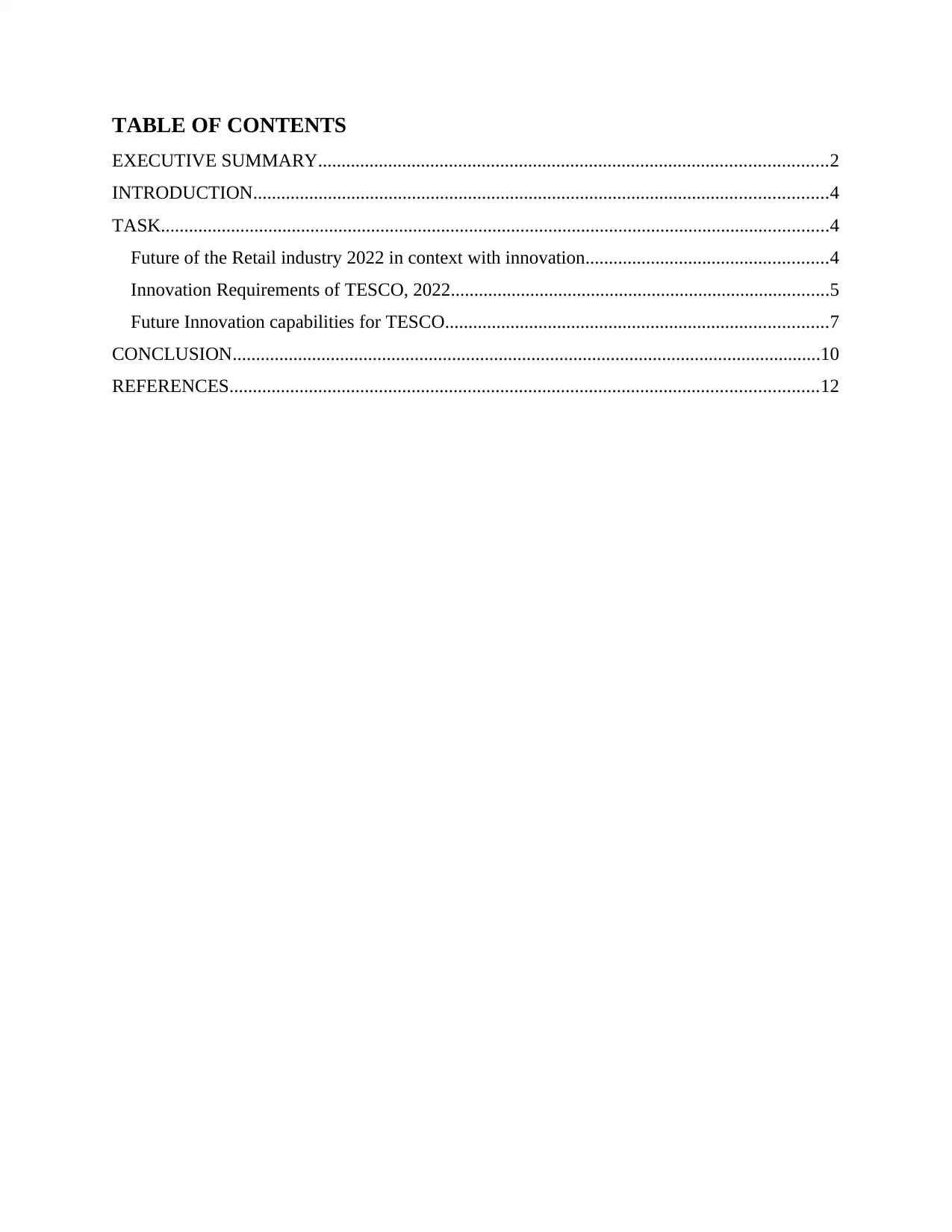
TABLE OF CONTENTS
EXECUTIVE SUMMARY.............................................................................................................2
INTRODUCTION...........................................................................................................................4
TASK...............................................................................................................................................4
Future of the Retail industry 2022 in context with innovation....................................................4
Innovation Requirements of TESCO, 2022.................................................................................5
Future Innovation capabilities for TESCO..................................................................................7
CONCLUSION..............................................................................................................................10
REFERENCES..............................................................................................................................12
EXECUTIVE SUMMARY.............................................................................................................2
INTRODUCTION...........................................................................................................................4
TASK...............................................................................................................................................4
Future of the Retail industry 2022 in context with innovation....................................................4
Innovation Requirements of TESCO, 2022.................................................................................5
Future Innovation capabilities for TESCO..................................................................................7
CONCLUSION..............................................................................................................................10
REFERENCES..............................................................................................................................12
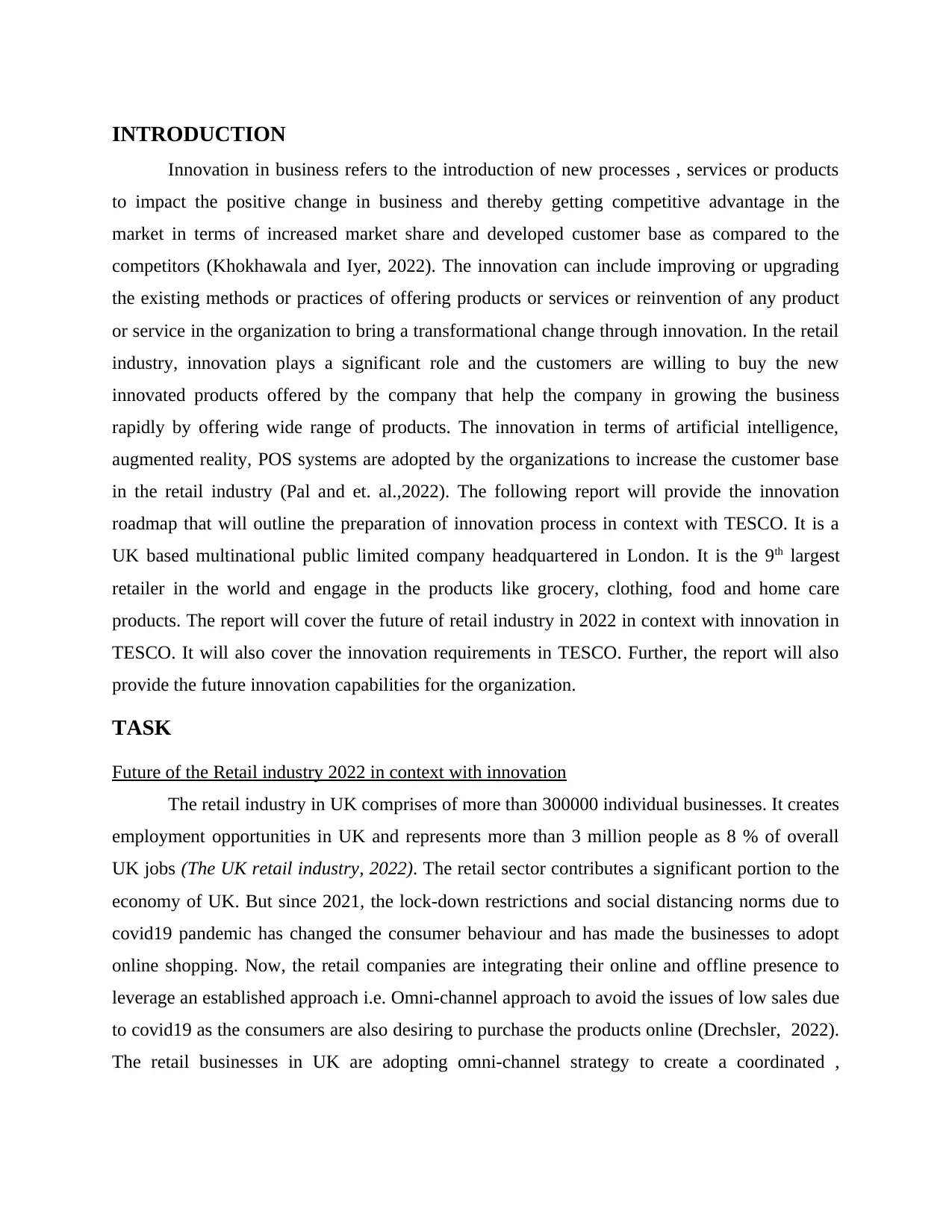
INTRODUCTION
Innovation in business refers to the introduction of new processes , services or products
to impact the positive change in business and thereby getting competitive advantage in the
market in terms of increased market share and developed customer base as compared to the
competitors (Khokhawala and Iyer, 2022). The innovation can include improving or upgrading
the existing methods or practices of offering products or services or reinvention of any product
or service in the organization to bring a transformational change through innovation. In the retail
industry, innovation plays a significant role and the customers are willing to buy the new
innovated products offered by the company that help the company in growing the business
rapidly by offering wide range of products. The innovation in terms of artificial intelligence,
augmented reality, POS systems are adopted by the organizations to increase the customer base
in the retail industry (Pal and et. al.,2022). The following report will provide the innovation
roadmap that will outline the preparation of innovation process in context with TESCO. It is a
UK based multinational public limited company headquartered in London. It is the 9th largest
retailer in the world and engage in the products like grocery, clothing, food and home care
products. The report will cover the future of retail industry in 2022 in context with innovation in
TESCO. It will also cover the innovation requirements in TESCO. Further, the report will also
provide the future innovation capabilities for the organization.
TASK
Future of the Retail industry 2022 in context with innovation
The retail industry in UK comprises of more than 300000 individual businesses. It creates
employment opportunities in UK and represents more than 3 million people as 8 % of overall
UK jobs (The UK retail industry, 2022). The retail sector contributes a significant portion to the
economy of UK. But since 2021, the lock-down restrictions and social distancing norms due to
covid19 pandemic has changed the consumer behaviour and has made the businesses to adopt
online shopping. Now, the retail companies are integrating their online and offline presence to
leverage an established approach i.e. Omni-channel approach to avoid the issues of low sales due
to covid19 as the consumers are also desiring to purchase the products online (Drechsler, 2022).
The retail businesses in UK are adopting omni-channel strategy to create a coordinated ,
Innovation in business refers to the introduction of new processes , services or products
to impact the positive change in business and thereby getting competitive advantage in the
market in terms of increased market share and developed customer base as compared to the
competitors (Khokhawala and Iyer, 2022). The innovation can include improving or upgrading
the existing methods or practices of offering products or services or reinvention of any product
or service in the organization to bring a transformational change through innovation. In the retail
industry, innovation plays a significant role and the customers are willing to buy the new
innovated products offered by the company that help the company in growing the business
rapidly by offering wide range of products. The innovation in terms of artificial intelligence,
augmented reality, POS systems are adopted by the organizations to increase the customer base
in the retail industry (Pal and et. al.,2022). The following report will provide the innovation
roadmap that will outline the preparation of innovation process in context with TESCO. It is a
UK based multinational public limited company headquartered in London. It is the 9th largest
retailer in the world and engage in the products like grocery, clothing, food and home care
products. The report will cover the future of retail industry in 2022 in context with innovation in
TESCO. It will also cover the innovation requirements in TESCO. Further, the report will also
provide the future innovation capabilities for the organization.
TASK
Future of the Retail industry 2022 in context with innovation
The retail industry in UK comprises of more than 300000 individual businesses. It creates
employment opportunities in UK and represents more than 3 million people as 8 % of overall
UK jobs (The UK retail industry, 2022). The retail sector contributes a significant portion to the
economy of UK. But since 2021, the lock-down restrictions and social distancing norms due to
covid19 pandemic has changed the consumer behaviour and has made the businesses to adopt
online shopping. Now, the retail companies are integrating their online and offline presence to
leverage an established approach i.e. Omni-channel approach to avoid the issues of low sales due
to covid19 as the consumers are also desiring to purchase the products online (Drechsler, 2022).
The retail businesses in UK are adopting omni-channel strategy to create a coordinated ,
Secure Best Marks with AI Grader
Need help grading? Try our AI Grader for instant feedback on your assignments.
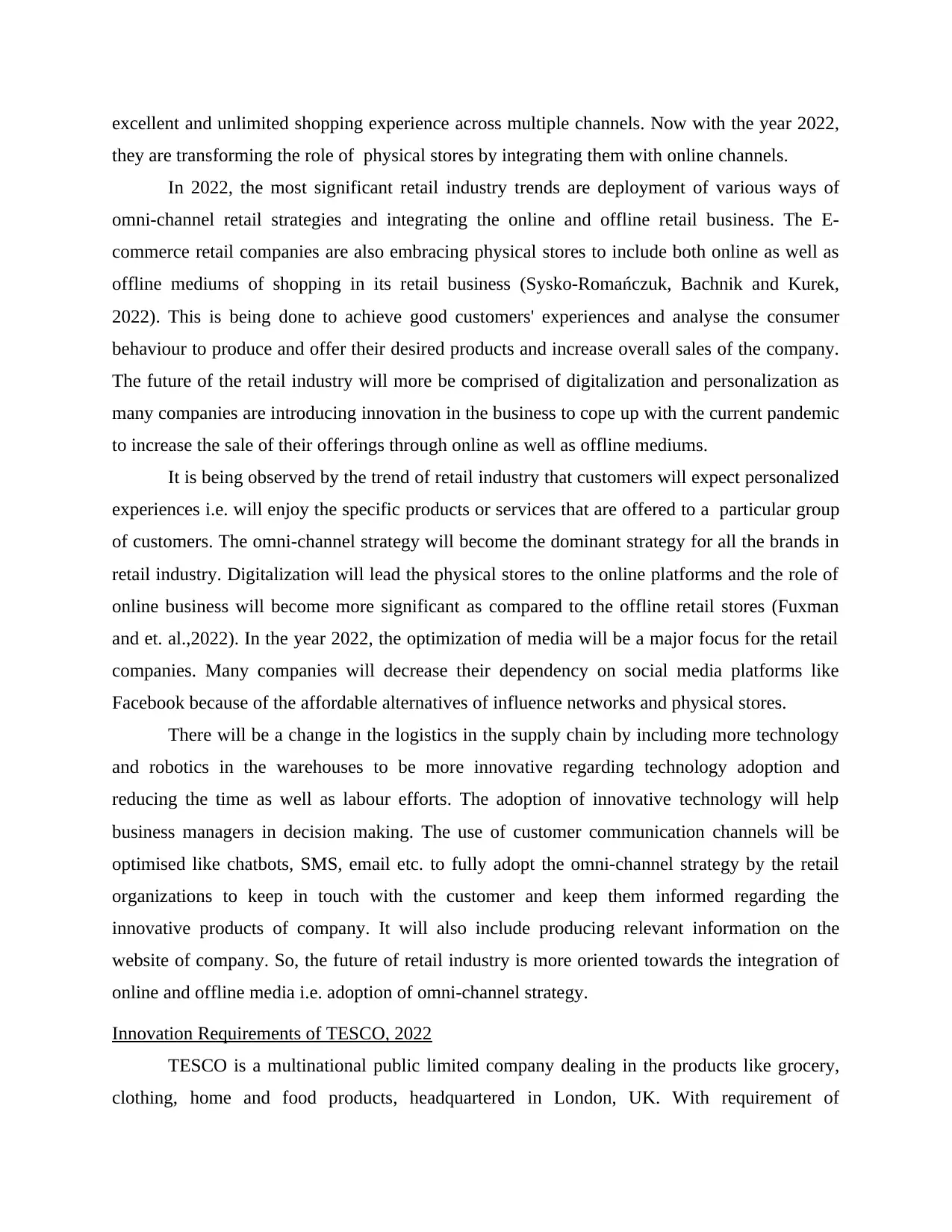
excellent and unlimited shopping experience across multiple channels. Now with the year 2022,
they are transforming the role of physical stores by integrating them with online channels.
In 2022, the most significant retail industry trends are deployment of various ways of
omni-channel retail strategies and integrating the online and offline retail business. The E-
commerce retail companies are also embracing physical stores to include both online as well as
offline mediums of shopping in its retail business (Sysko-Romańczuk, Bachnik and Kurek,
2022). This is being done to achieve good customers' experiences and analyse the consumer
behaviour to produce and offer their desired products and increase overall sales of the company.
The future of the retail industry will more be comprised of digitalization and personalization as
many companies are introducing innovation in the business to cope up with the current pandemic
to increase the sale of their offerings through online as well as offline mediums.
It is being observed by the trend of retail industry that customers will expect personalized
experiences i.e. will enjoy the specific products or services that are offered to a particular group
of customers. The omni-channel strategy will become the dominant strategy for all the brands in
retail industry. Digitalization will lead the physical stores to the online platforms and the role of
online business will become more significant as compared to the offline retail stores (Fuxman
and et. al.,2022). In the year 2022, the optimization of media will be a major focus for the retail
companies. Many companies will decrease their dependency on social media platforms like
Facebook because of the affordable alternatives of influence networks and physical stores.
There will be a change in the logistics in the supply chain by including more technology
and robotics in the warehouses to be more innovative regarding technology adoption and
reducing the time as well as labour efforts. The adoption of innovative technology will help
business managers in decision making. The use of customer communication channels will be
optimised like chatbots, SMS, email etc. to fully adopt the omni-channel strategy by the retail
organizations to keep in touch with the customer and keep them informed regarding the
innovative products of company. It will also include producing relevant information on the
website of company. So, the future of retail industry is more oriented towards the integration of
online and offline media i.e. adoption of omni-channel strategy.
Innovation Requirements of TESCO, 2022
TESCO is a multinational public limited company dealing in the products like grocery,
clothing, home and food products, headquartered in London, UK. With requirement of
they are transforming the role of physical stores by integrating them with online channels.
In 2022, the most significant retail industry trends are deployment of various ways of
omni-channel retail strategies and integrating the online and offline retail business. The E-
commerce retail companies are also embracing physical stores to include both online as well as
offline mediums of shopping in its retail business (Sysko-Romańczuk, Bachnik and Kurek,
2022). This is being done to achieve good customers' experiences and analyse the consumer
behaviour to produce and offer their desired products and increase overall sales of the company.
The future of the retail industry will more be comprised of digitalization and personalization as
many companies are introducing innovation in the business to cope up with the current pandemic
to increase the sale of their offerings through online as well as offline mediums.
It is being observed by the trend of retail industry that customers will expect personalized
experiences i.e. will enjoy the specific products or services that are offered to a particular group
of customers. The omni-channel strategy will become the dominant strategy for all the brands in
retail industry. Digitalization will lead the physical stores to the online platforms and the role of
online business will become more significant as compared to the offline retail stores (Fuxman
and et. al.,2022). In the year 2022, the optimization of media will be a major focus for the retail
companies. Many companies will decrease their dependency on social media platforms like
Facebook because of the affordable alternatives of influence networks and physical stores.
There will be a change in the logistics in the supply chain by including more technology
and robotics in the warehouses to be more innovative regarding technology adoption and
reducing the time as well as labour efforts. The adoption of innovative technology will help
business managers in decision making. The use of customer communication channels will be
optimised like chatbots, SMS, email etc. to fully adopt the omni-channel strategy by the retail
organizations to keep in touch with the customer and keep them informed regarding the
innovative products of company. It will also include producing relevant information on the
website of company. So, the future of retail industry is more oriented towards the integration of
online and offline media i.e. adoption of omni-channel strategy.
Innovation Requirements of TESCO, 2022
TESCO is a multinational public limited company dealing in the products like grocery,
clothing, home and food products, headquartered in London, UK. With requirement of
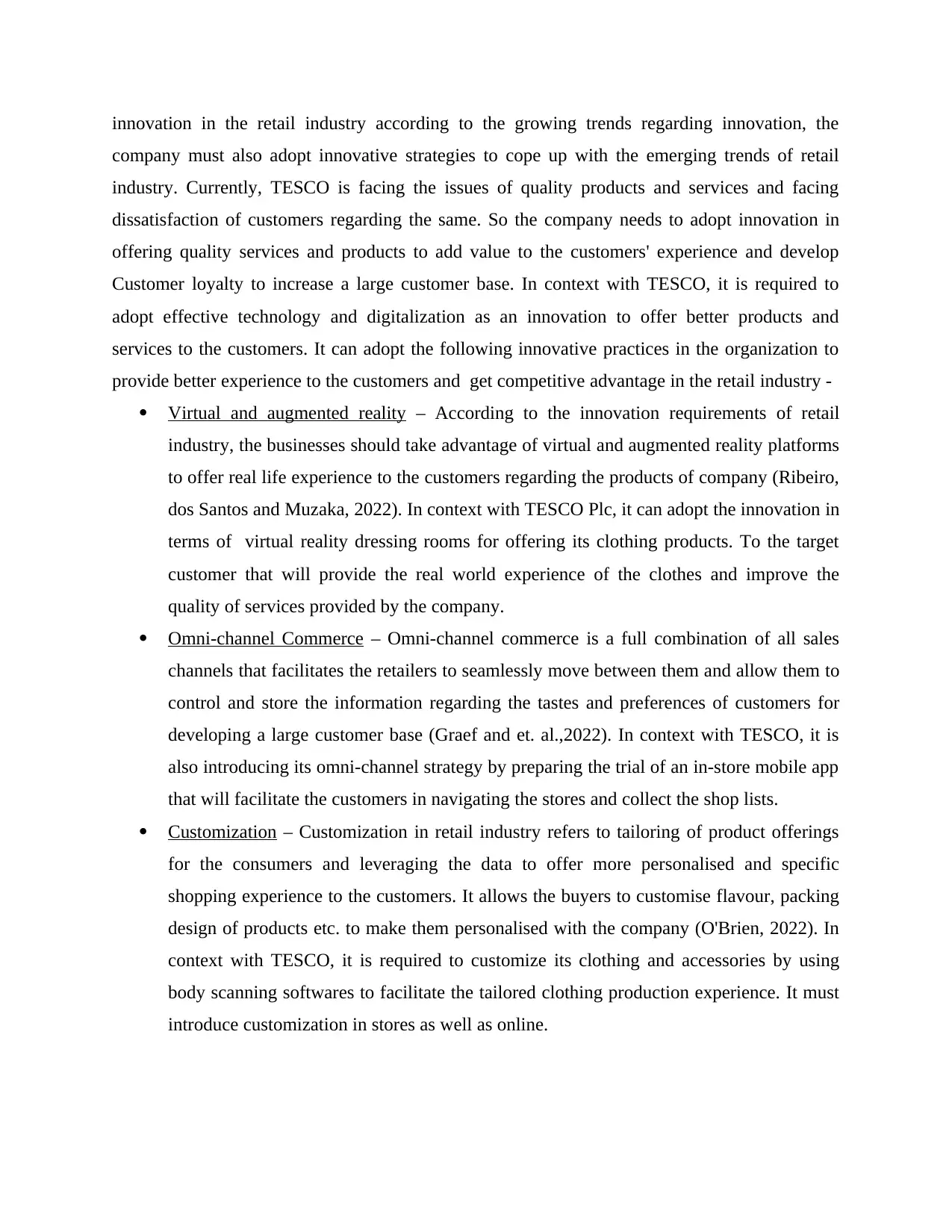
innovation in the retail industry according to the growing trends regarding innovation, the
company must also adopt innovative strategies to cope up with the emerging trends of retail
industry. Currently, TESCO is facing the issues of quality products and services and facing
dissatisfaction of customers regarding the same. So the company needs to adopt innovation in
offering quality services and products to add value to the customers' experience and develop
Customer loyalty to increase a large customer base. In context with TESCO, it is required to
adopt effective technology and digitalization as an innovation to offer better products and
services to the customers. It can adopt the following innovative practices in the organization to
provide better experience to the customers and get competitive advantage in the retail industry -
Virtual and augmented reality – According to the innovation requirements of retail
industry, the businesses should take advantage of virtual and augmented reality platforms
to offer real life experience to the customers regarding the products of company (Ribeiro,
dos Santos and Muzaka, 2022). In context with TESCO Plc, it can adopt the innovation in
terms of virtual reality dressing rooms for offering its clothing products. To the target
customer that will provide the real world experience of the clothes and improve the
quality of services provided by the company.
Omni-channel Commerce – Omni-channel commerce is a full combination of all sales
channels that facilitates the retailers to seamlessly move between them and allow them to
control and store the information regarding the tastes and preferences of customers for
developing a large customer base (Graef and et. al.,2022). In context with TESCO, it is
also introducing its omni-channel strategy by preparing the trial of an in-store mobile app
that will facilitate the customers in navigating the stores and collect the shop lists.
Customization – Customization in retail industry refers to tailoring of product offerings
for the consumers and leveraging the data to offer more personalised and specific
shopping experience to the customers. It allows the buyers to customise flavour, packing
design of products etc. to make them personalised with the company (O'Brien, 2022). In
context with TESCO, it is required to customize its clothing and accessories by using
body scanning softwares to facilitate the tailored clothing production experience. It must
introduce customization in stores as well as online.
company must also adopt innovative strategies to cope up with the emerging trends of retail
industry. Currently, TESCO is facing the issues of quality products and services and facing
dissatisfaction of customers regarding the same. So the company needs to adopt innovation in
offering quality services and products to add value to the customers' experience and develop
Customer loyalty to increase a large customer base. In context with TESCO, it is required to
adopt effective technology and digitalization as an innovation to offer better products and
services to the customers. It can adopt the following innovative practices in the organization to
provide better experience to the customers and get competitive advantage in the retail industry -
Virtual and augmented reality – According to the innovation requirements of retail
industry, the businesses should take advantage of virtual and augmented reality platforms
to offer real life experience to the customers regarding the products of company (Ribeiro,
dos Santos and Muzaka, 2022). In context with TESCO Plc, it can adopt the innovation in
terms of virtual reality dressing rooms for offering its clothing products. To the target
customer that will provide the real world experience of the clothes and improve the
quality of services provided by the company.
Omni-channel Commerce – Omni-channel commerce is a full combination of all sales
channels that facilitates the retailers to seamlessly move between them and allow them to
control and store the information regarding the tastes and preferences of customers for
developing a large customer base (Graef and et. al.,2022). In context with TESCO, it is
also introducing its omni-channel strategy by preparing the trial of an in-store mobile app
that will facilitate the customers in navigating the stores and collect the shop lists.
Customization – Customization in retail industry refers to tailoring of product offerings
for the consumers and leveraging the data to offer more personalised and specific
shopping experience to the customers. It allows the buyers to customise flavour, packing
design of products etc. to make them personalised with the company (O'Brien, 2022). In
context with TESCO, it is required to customize its clothing and accessories by using
body scanning softwares to facilitate the tailored clothing production experience. It must
introduce customization in stores as well as online.
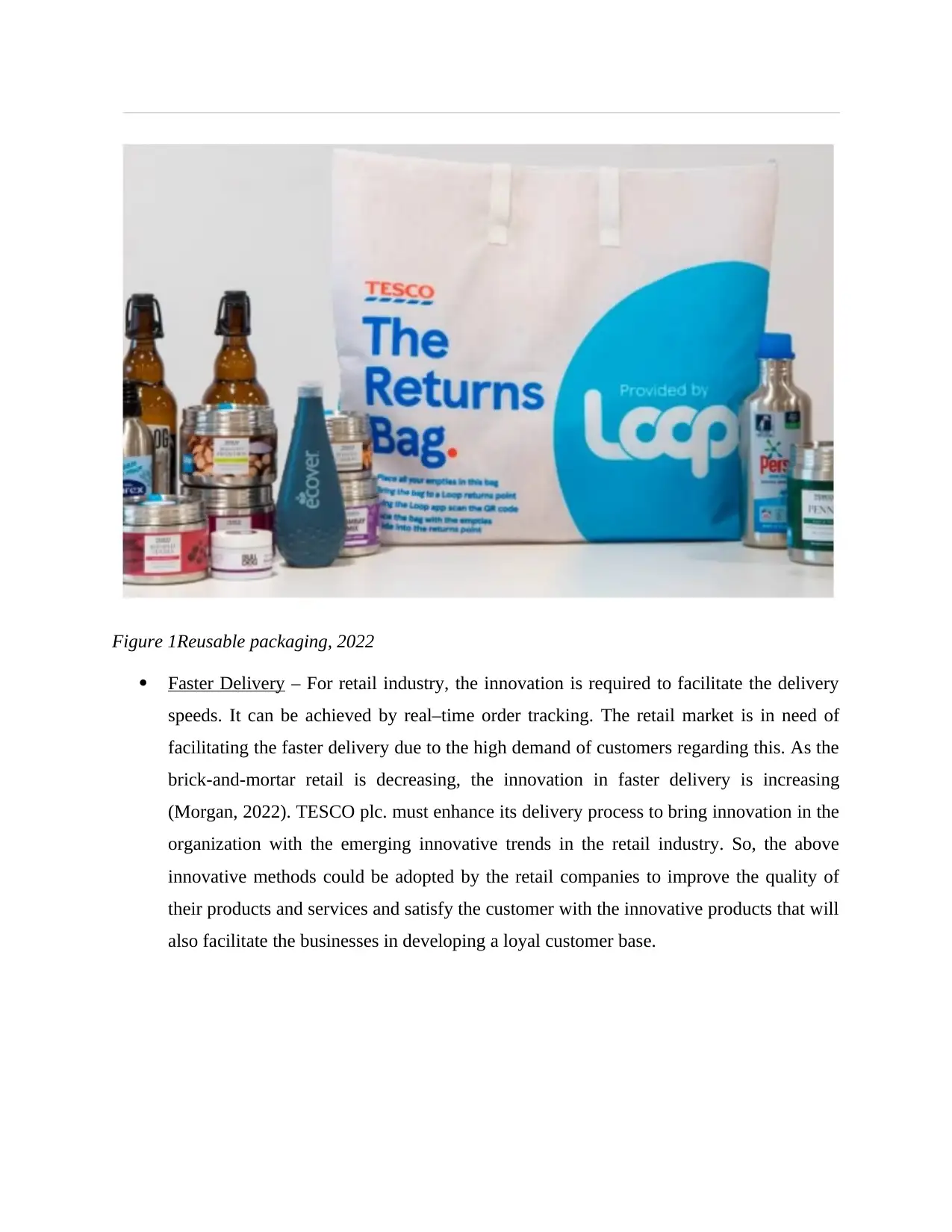
Figure 1Reusable packaging, 2022
Faster Delivery – For retail industry, the innovation is required to facilitate the delivery
speeds. It can be achieved by real–time order tracking. The retail market is in need of
facilitating the faster delivery due to the high demand of customers regarding this. As the
brick-and-mortar retail is decreasing, the innovation in faster delivery is increasing
(Morgan, 2022). TESCO plc. must enhance its delivery process to bring innovation in the
organization with the emerging innovative trends in the retail industry. So, the above
innovative methods could be adopted by the retail companies to improve the quality of
their products and services and satisfy the customer with the innovative products that will
also facilitate the businesses in developing a loyal customer base.
Faster Delivery – For retail industry, the innovation is required to facilitate the delivery
speeds. It can be achieved by real–time order tracking. The retail market is in need of
facilitating the faster delivery due to the high demand of customers regarding this. As the
brick-and-mortar retail is decreasing, the innovation in faster delivery is increasing
(Morgan, 2022). TESCO plc. must enhance its delivery process to bring innovation in the
organization with the emerging innovative trends in the retail industry. So, the above
innovative methods could be adopted by the retail companies to improve the quality of
their products and services and satisfy the customer with the innovative products that will
also facilitate the businesses in developing a loyal customer base.
Paraphrase This Document
Need a fresh take? Get an instant paraphrase of this document with our AI Paraphraser

Figure 2GetGo Checkout, 2022
Future Innovation capabilities for TESCO
Innovation capabilities can be defined as the ability of a firm or a business to identify the
new ideas ad transform them into new or improved products, services or business processes to
provide competitive advantage to the business. The innovation in retail industry is about bringing
transformation to provide tangible value to the shoppers. The innovation in this industry can be
introduced through new developments and improvements in technology, products, services and
business systems. It provides convenience and value for the customer and as regards retailers, it
ensures growth and competitive advantage for their businesses (Ghazwani and et. al.,2022). As
there are emerging trends in retail industry as of 2022 that include selling online, creating good
shopping experiences through omni-channel tools , managing the labour shortage through
automated technology, ensuring the same–day delivery etc. , the retail businesses need to cope
up with these trends to be stable in the industry by developing a large customer base.
Future Innovation capabilities for TESCO
Innovation capabilities can be defined as the ability of a firm or a business to identify the
new ideas ad transform them into new or improved products, services or business processes to
provide competitive advantage to the business. The innovation in retail industry is about bringing
transformation to provide tangible value to the shoppers. The innovation in this industry can be
introduced through new developments and improvements in technology, products, services and
business systems. It provides convenience and value for the customer and as regards retailers, it
ensures growth and competitive advantage for their businesses (Ghazwani and et. al.,2022). As
there are emerging trends in retail industry as of 2022 that include selling online, creating good
shopping experiences through omni-channel tools , managing the labour shortage through
automated technology, ensuring the same–day delivery etc. , the retail businesses need to cope
up with these trends to be stable in the industry by developing a large customer base.
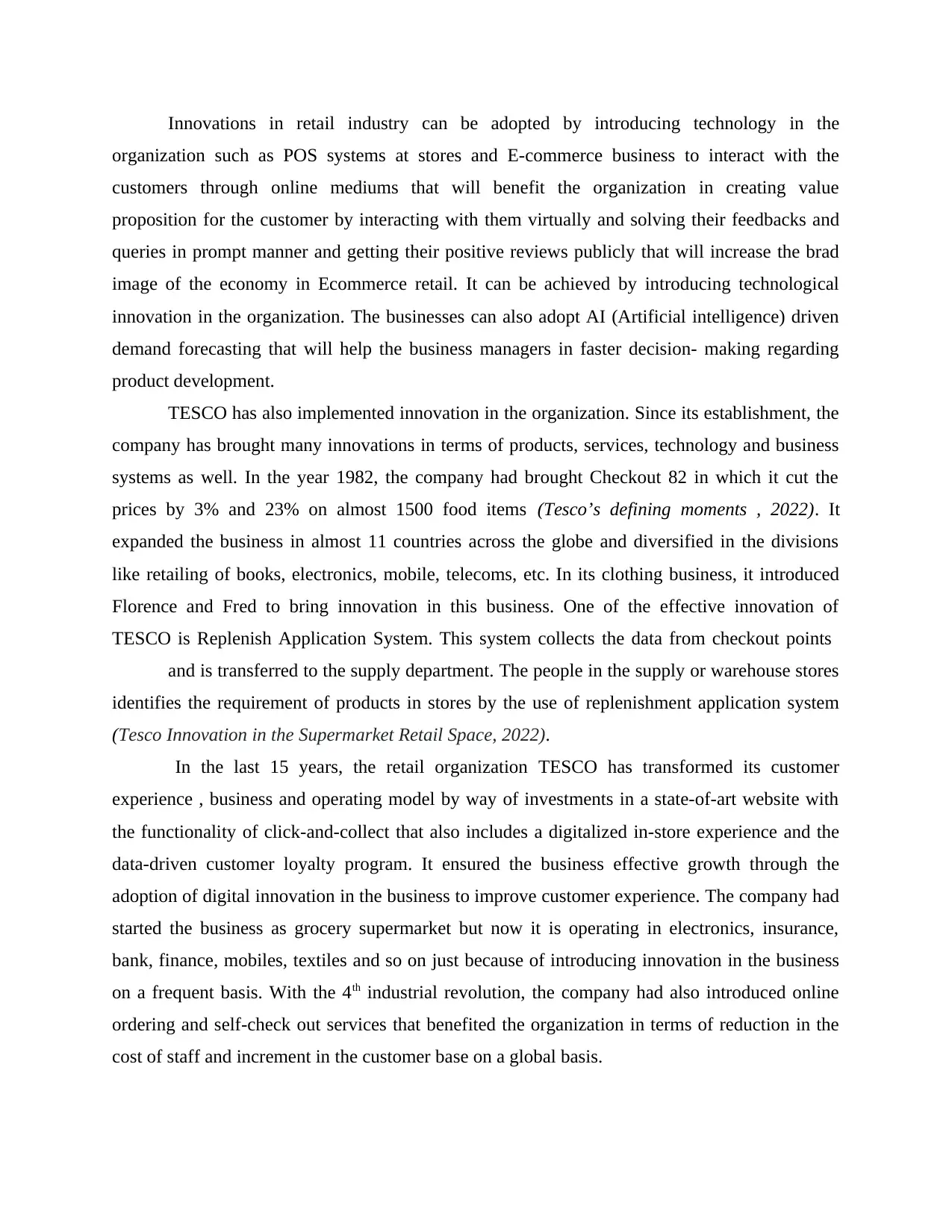
Innovations in retail industry can be adopted by introducing technology in the
organization such as POS systems at stores and E-commerce business to interact with the
customers through online mediums that will benefit the organization in creating value
proposition for the customer by interacting with them virtually and solving their feedbacks and
queries in prompt manner and getting their positive reviews publicly that will increase the brad
image of the economy in Ecommerce retail. It can be achieved by introducing technological
innovation in the organization. The businesses can also adopt AI (Artificial intelligence) driven
demand forecasting that will help the business managers in faster decision- making regarding
product development.
TESCO has also implemented innovation in the organization. Since its establishment, the
company has brought many innovations in terms of products, services, technology and business
systems as well. In the year 1982, the company had brought Checkout 82 in which it cut the
prices by 3% and 23% on almost 1500 food items (Tesco’s defining moments , 2022). It
expanded the business in almost 11 countries across the globe and diversified in the divisions
like retailing of books, electronics, mobile, telecoms, etc. In its clothing business, it introduced
Florence and Fred to bring innovation in this business. One of the effective innovation of
TESCO is Replenish Application System. This system collects the data from checkout points
and is transferred to the supply department. The people in the supply or warehouse stores
identifies the requirement of products in stores by the use of replenishment application system
(Tesco Innovation in the Supermarket Retail Space, 2022).
In the last 15 years, the retail organization TESCO has transformed its customer
experience , business and operating model by way of investments in a state-of-art website with
the functionality of click-and-collect that also includes a digitalized in-store experience and the
data-driven customer loyalty program. It ensured the business effective growth through the
adoption of digital innovation in the business to improve customer experience. The company had
started the business as grocery supermarket but now it is operating in electronics, insurance,
bank, finance, mobiles, textiles and so on just because of introducing innovation in the business
on a frequent basis. With the 4th industrial revolution, the company had also introduced online
ordering and self-check out services that benefited the organization in terms of reduction in the
cost of staff and increment in the customer base on a global basis.
organization such as POS systems at stores and E-commerce business to interact with the
customers through online mediums that will benefit the organization in creating value
proposition for the customer by interacting with them virtually and solving their feedbacks and
queries in prompt manner and getting their positive reviews publicly that will increase the brad
image of the economy in Ecommerce retail. It can be achieved by introducing technological
innovation in the organization. The businesses can also adopt AI (Artificial intelligence) driven
demand forecasting that will help the business managers in faster decision- making regarding
product development.
TESCO has also implemented innovation in the organization. Since its establishment, the
company has brought many innovations in terms of products, services, technology and business
systems as well. In the year 1982, the company had brought Checkout 82 in which it cut the
prices by 3% and 23% on almost 1500 food items (Tesco’s defining moments , 2022). It
expanded the business in almost 11 countries across the globe and diversified in the divisions
like retailing of books, electronics, mobile, telecoms, etc. In its clothing business, it introduced
Florence and Fred to bring innovation in this business. One of the effective innovation of
TESCO is Replenish Application System. This system collects the data from checkout points
and is transferred to the supply department. The people in the supply or warehouse stores
identifies the requirement of products in stores by the use of replenishment application system
(Tesco Innovation in the Supermarket Retail Space, 2022).
In the last 15 years, the retail organization TESCO has transformed its customer
experience , business and operating model by way of investments in a state-of-art website with
the functionality of click-and-collect that also includes a digitalized in-store experience and the
data-driven customer loyalty program. It ensured the business effective growth through the
adoption of digital innovation in the business to improve customer experience. The company had
started the business as grocery supermarket but now it is operating in electronics, insurance,
bank, finance, mobiles, textiles and so on just because of introducing innovation in the business
on a frequent basis. With the 4th industrial revolution, the company had also introduced online
ordering and self-check out services that benefited the organization in terms of reduction in the
cost of staff and increment in the customer base on a global basis.
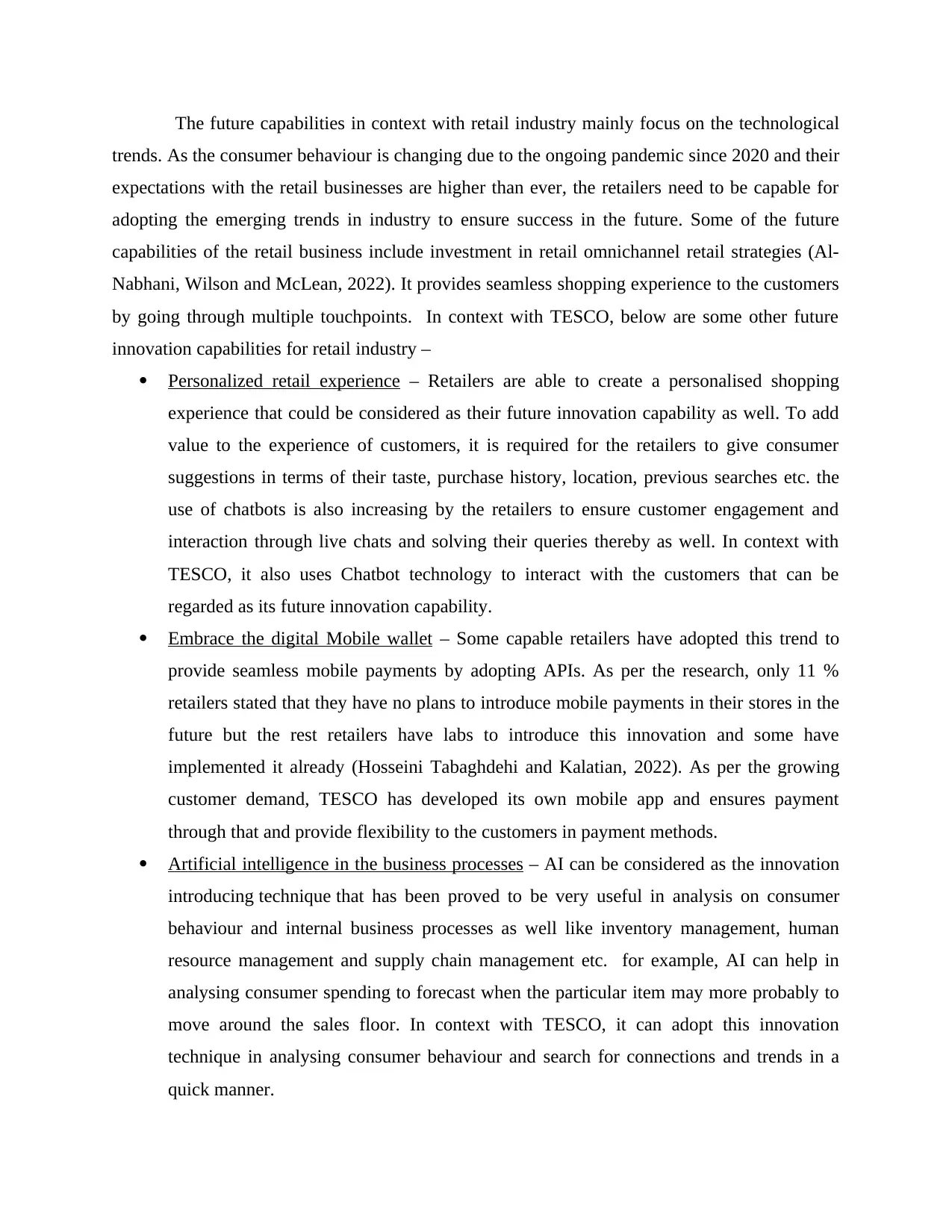
The future capabilities in context with retail industry mainly focus on the technological
trends. As the consumer behaviour is changing due to the ongoing pandemic since 2020 and their
expectations with the retail businesses are higher than ever, the retailers need to be capable for
adopting the emerging trends in industry to ensure success in the future. Some of the future
capabilities of the retail business include investment in retail omnichannel retail strategies (Al‐
Nabhani, Wilson and McLean, 2022). It provides seamless shopping experience to the customers
by going through multiple touchpoints. In context with TESCO, below are some other future
innovation capabilities for retail industry –
Personalized retail experience – Retailers are able to create a personalised shopping
experience that could be considered as their future innovation capability as well. To add
value to the experience of customers, it is required for the retailers to give consumer
suggestions in terms of their taste, purchase history, location, previous searches etc. the
use of chatbots is also increasing by the retailers to ensure customer engagement and
interaction through live chats and solving their queries thereby as well. In context with
TESCO, it also uses Chatbot technology to interact with the customers that can be
regarded as its future innovation capability.
Embrace the digital Mobile wallet – Some capable retailers have adopted this trend to
provide seamless mobile payments by adopting APIs. As per the research, only 11 %
retailers stated that they have no plans to introduce mobile payments in their stores in the
future but the rest retailers have labs to introduce this innovation and some have
implemented it already (Hosseini Tabaghdehi and Kalatian, 2022). As per the growing
customer demand, TESCO has developed its own mobile app and ensures payment
through that and provide flexibility to the customers in payment methods.
Artificial intelligence in the business processes – AI can be considered as the innovation
introducing technique that has been proved to be very useful in analysis on consumer
behaviour and internal business processes as well like inventory management, human
resource management and supply chain management etc. for example, AI can help in
analysing consumer spending to forecast when the particular item may more probably to
move around the sales floor. In context with TESCO, it can adopt this innovation
technique in analysing consumer behaviour and search for connections and trends in a
quick manner.
trends. As the consumer behaviour is changing due to the ongoing pandemic since 2020 and their
expectations with the retail businesses are higher than ever, the retailers need to be capable for
adopting the emerging trends in industry to ensure success in the future. Some of the future
capabilities of the retail business include investment in retail omnichannel retail strategies (Al‐
Nabhani, Wilson and McLean, 2022). It provides seamless shopping experience to the customers
by going through multiple touchpoints. In context with TESCO, below are some other future
innovation capabilities for retail industry –
Personalized retail experience – Retailers are able to create a personalised shopping
experience that could be considered as their future innovation capability as well. To add
value to the experience of customers, it is required for the retailers to give consumer
suggestions in terms of their taste, purchase history, location, previous searches etc. the
use of chatbots is also increasing by the retailers to ensure customer engagement and
interaction through live chats and solving their queries thereby as well. In context with
TESCO, it also uses Chatbot technology to interact with the customers that can be
regarded as its future innovation capability.
Embrace the digital Mobile wallet – Some capable retailers have adopted this trend to
provide seamless mobile payments by adopting APIs. As per the research, only 11 %
retailers stated that they have no plans to introduce mobile payments in their stores in the
future but the rest retailers have labs to introduce this innovation and some have
implemented it already (Hosseini Tabaghdehi and Kalatian, 2022). As per the growing
customer demand, TESCO has developed its own mobile app and ensures payment
through that and provide flexibility to the customers in payment methods.
Artificial intelligence in the business processes – AI can be considered as the innovation
introducing technique that has been proved to be very useful in analysis on consumer
behaviour and internal business processes as well like inventory management, human
resource management and supply chain management etc. for example, AI can help in
analysing consumer spending to forecast when the particular item may more probably to
move around the sales floor. In context with TESCO, it can adopt this innovation
technique in analysing consumer behaviour and search for connections and trends in a
quick manner.
Secure Best Marks with AI Grader
Need help grading? Try our AI Grader for instant feedback on your assignments.
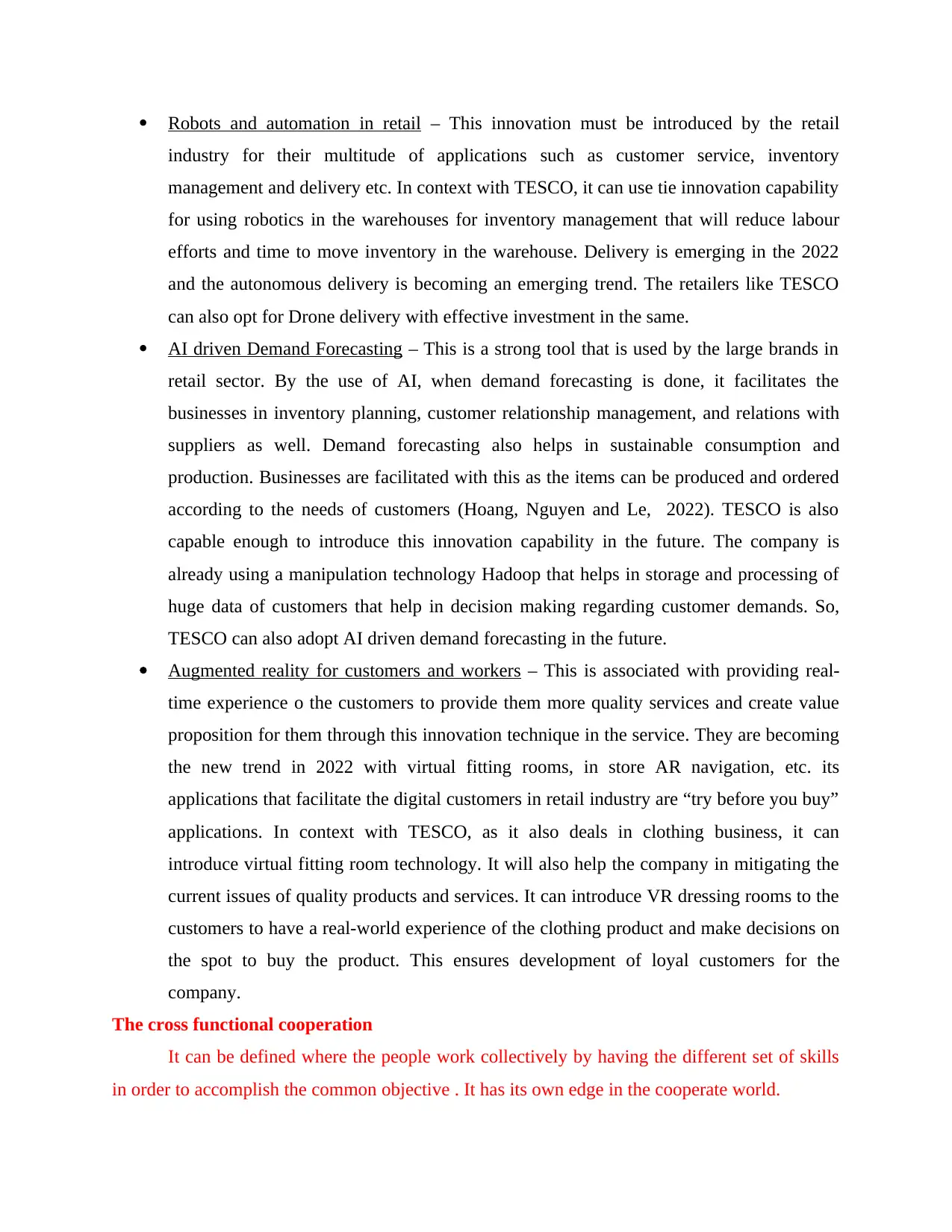
Robots and automation in retail – This innovation must be introduced by the retail
industry for their multitude of applications such as customer service, inventory
management and delivery etc. In context with TESCO, it can use tie innovation capability
for using robotics in the warehouses for inventory management that will reduce labour
efforts and time to move inventory in the warehouse. Delivery is emerging in the 2022
and the autonomous delivery is becoming an emerging trend. The retailers like TESCO
can also opt for Drone delivery with effective investment in the same.
AI driven Demand Forecasting – This is a strong tool that is used by the large brands in
retail sector. By the use of AI, when demand forecasting is done, it facilitates the
businesses in inventory planning, customer relationship management, and relations with
suppliers as well. Demand forecasting also helps in sustainable consumption and
production. Businesses are facilitated with this as the items can be produced and ordered
according to the needs of customers (Hoang, Nguyen and Le, 2022). TESCO is also
capable enough to introduce this innovation capability in the future. The company is
already using a manipulation technology Hadoop that helps in storage and processing of
huge data of customers that help in decision making regarding customer demands. So,
TESCO can also adopt AI driven demand forecasting in the future.
Augmented reality for customers and workers – This is associated with providing real-
time experience o the customers to provide them more quality services and create value
proposition for them through this innovation technique in the service. They are becoming
the new trend in 2022 with virtual fitting rooms, in store AR navigation, etc. its
applications that facilitate the digital customers in retail industry are “try before you buy”
applications. In context with TESCO, as it also deals in clothing business, it can
introduce virtual fitting room technology. It will also help the company in mitigating the
current issues of quality products and services. It can introduce VR dressing rooms to the
customers to have a real-world experience of the clothing product and make decisions on
the spot to buy the product. This ensures development of loyal customers for the
company.
The cross functional cooperation
It can be defined where the people work collectively by having the different set of skills
in order to accomplish the common objective . It has its own edge in the cooperate world.
industry for their multitude of applications such as customer service, inventory
management and delivery etc. In context with TESCO, it can use tie innovation capability
for using robotics in the warehouses for inventory management that will reduce labour
efforts and time to move inventory in the warehouse. Delivery is emerging in the 2022
and the autonomous delivery is becoming an emerging trend. The retailers like TESCO
can also opt for Drone delivery with effective investment in the same.
AI driven Demand Forecasting – This is a strong tool that is used by the large brands in
retail sector. By the use of AI, when demand forecasting is done, it facilitates the
businesses in inventory planning, customer relationship management, and relations with
suppliers as well. Demand forecasting also helps in sustainable consumption and
production. Businesses are facilitated with this as the items can be produced and ordered
according to the needs of customers (Hoang, Nguyen and Le, 2022). TESCO is also
capable enough to introduce this innovation capability in the future. The company is
already using a manipulation technology Hadoop that helps in storage and processing of
huge data of customers that help in decision making regarding customer demands. So,
TESCO can also adopt AI driven demand forecasting in the future.
Augmented reality for customers and workers – This is associated with providing real-
time experience o the customers to provide them more quality services and create value
proposition for them through this innovation technique in the service. They are becoming
the new trend in 2022 with virtual fitting rooms, in store AR navigation, etc. its
applications that facilitate the digital customers in retail industry are “try before you buy”
applications. In context with TESCO, as it also deals in clothing business, it can
introduce virtual fitting room technology. It will also help the company in mitigating the
current issues of quality products and services. It can introduce VR dressing rooms to the
customers to have a real-world experience of the clothing product and make decisions on
the spot to buy the product. This ensures development of loyal customers for the
company.
The cross functional cooperation
It can be defined where the people work collectively by having the different set of skills
in order to accomplish the common objective . It has its own edge in the cooperate world.
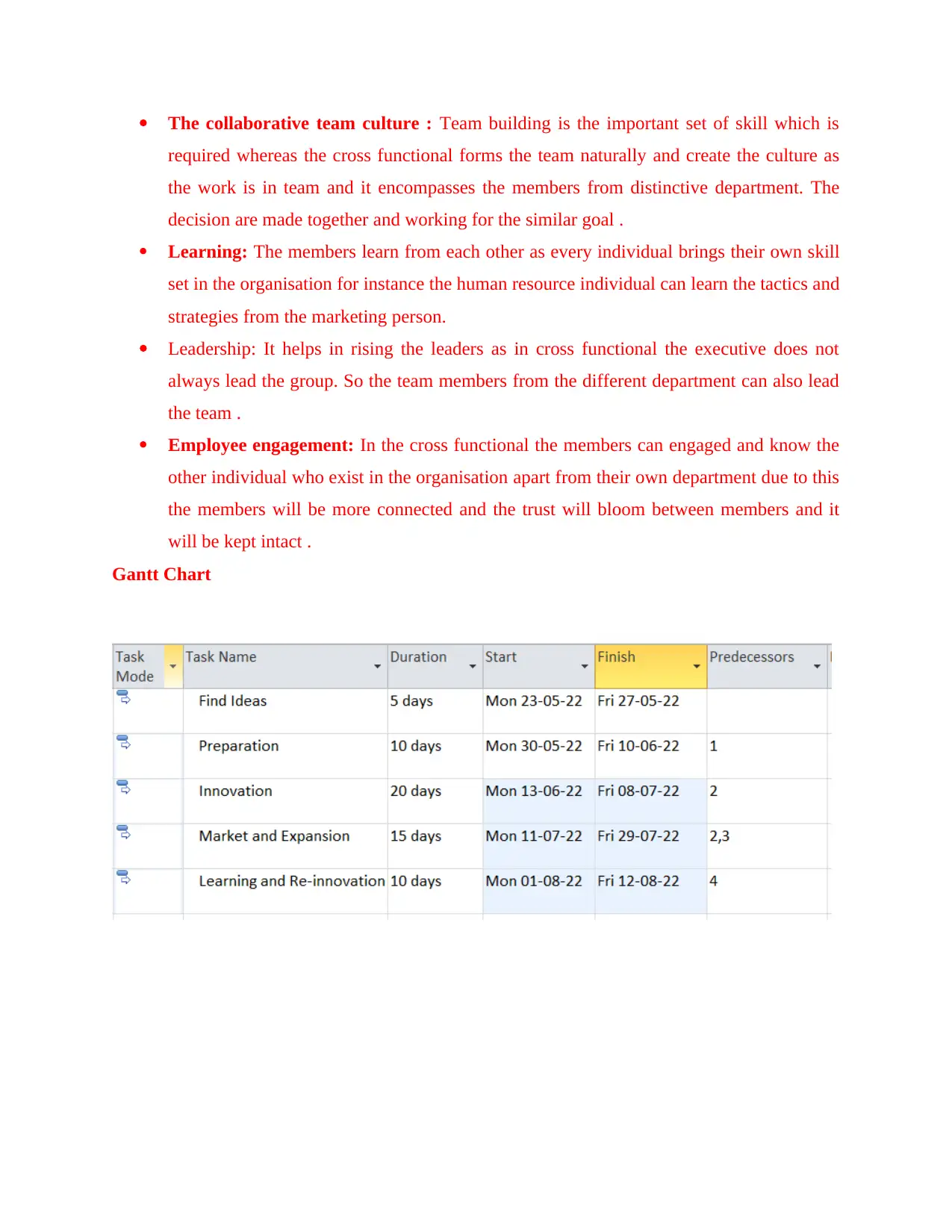
The collaborative team culture : Team building is the important set of skill which is
required whereas the cross functional forms the team naturally and create the culture as
the work is in team and it encompasses the members from distinctive department. The
decision are made together and working for the similar goal .
Learning: The members learn from each other as every individual brings their own skill
set in the organisation for instance the human resource individual can learn the tactics and
strategies from the marketing person.
Leadership: It helps in rising the leaders as in cross functional the executive does not
always lead the group. So the team members from the different department can also lead
the team .
Employee engagement: In the cross functional the members can engaged and know the
other individual who exist in the organisation apart from their own department due to this
the members will be more connected and the trust will bloom between members and it
will be kept intact .
Gantt Chart
required whereas the cross functional forms the team naturally and create the culture as
the work is in team and it encompasses the members from distinctive department. The
decision are made together and working for the similar goal .
Learning: The members learn from each other as every individual brings their own skill
set in the organisation for instance the human resource individual can learn the tactics and
strategies from the marketing person.
Leadership: It helps in rising the leaders as in cross functional the executive does not
always lead the group. So the team members from the different department can also lead
the team .
Employee engagement: In the cross functional the members can engaged and know the
other individual who exist in the organisation apart from their own department due to this
the members will be more connected and the trust will bloom between members and it
will be kept intact .
Gantt Chart
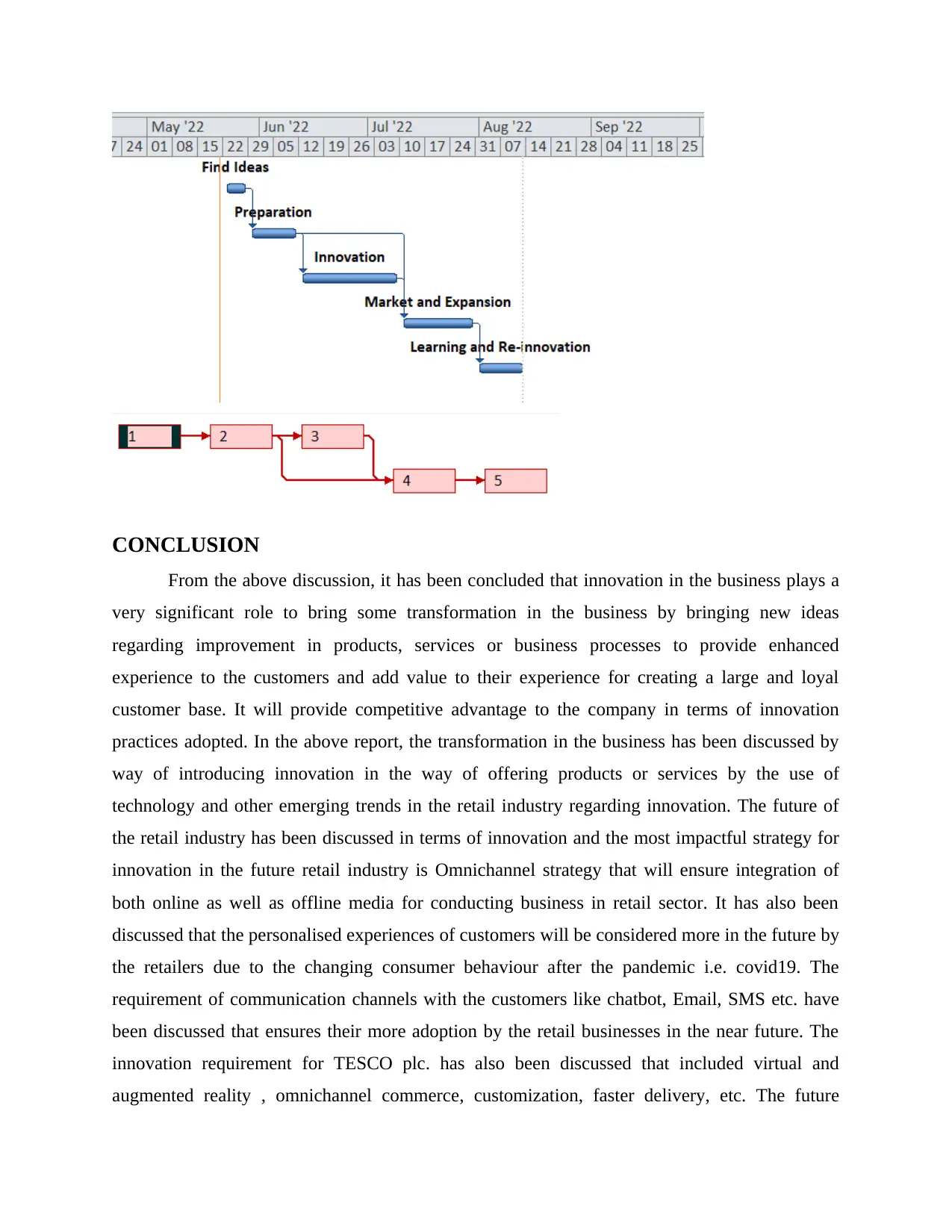
CONCLUSION
From the above discussion, it has been concluded that innovation in the business plays a
very significant role to bring some transformation in the business by bringing new ideas
regarding improvement in products, services or business processes to provide enhanced
experience to the customers and add value to their experience for creating a large and loyal
customer base. It will provide competitive advantage to the company in terms of innovation
practices adopted. In the above report, the transformation in the business has been discussed by
way of introducing innovation in the way of offering products or services by the use of
technology and other emerging trends in the retail industry regarding innovation. The future of
the retail industry has been discussed in terms of innovation and the most impactful strategy for
innovation in the future retail industry is Omnichannel strategy that will ensure integration of
both online as well as offline media for conducting business in retail sector. It has also been
discussed that the personalised experiences of customers will be considered more in the future by
the retailers due to the changing consumer behaviour after the pandemic i.e. covid19. The
requirement of communication channels with the customers like chatbot, Email, SMS etc. have
been discussed that ensures their more adoption by the retail businesses in the near future. The
innovation requirement for TESCO plc. has also been discussed that included virtual and
augmented reality , omnichannel commerce, customization, faster delivery, etc. The future
From the above discussion, it has been concluded that innovation in the business plays a
very significant role to bring some transformation in the business by bringing new ideas
regarding improvement in products, services or business processes to provide enhanced
experience to the customers and add value to their experience for creating a large and loyal
customer base. It will provide competitive advantage to the company in terms of innovation
practices adopted. In the above report, the transformation in the business has been discussed by
way of introducing innovation in the way of offering products or services by the use of
technology and other emerging trends in the retail industry regarding innovation. The future of
the retail industry has been discussed in terms of innovation and the most impactful strategy for
innovation in the future retail industry is Omnichannel strategy that will ensure integration of
both online as well as offline media for conducting business in retail sector. It has also been
discussed that the personalised experiences of customers will be considered more in the future by
the retailers due to the changing consumer behaviour after the pandemic i.e. covid19. The
requirement of communication channels with the customers like chatbot, Email, SMS etc. have
been discussed that ensures their more adoption by the retail businesses in the near future. The
innovation requirement for TESCO plc. has also been discussed that included virtual and
augmented reality , omnichannel commerce, customization, faster delivery, etc. The future
Paraphrase This Document
Need a fresh take? Get an instant paraphrase of this document with our AI Paraphraser
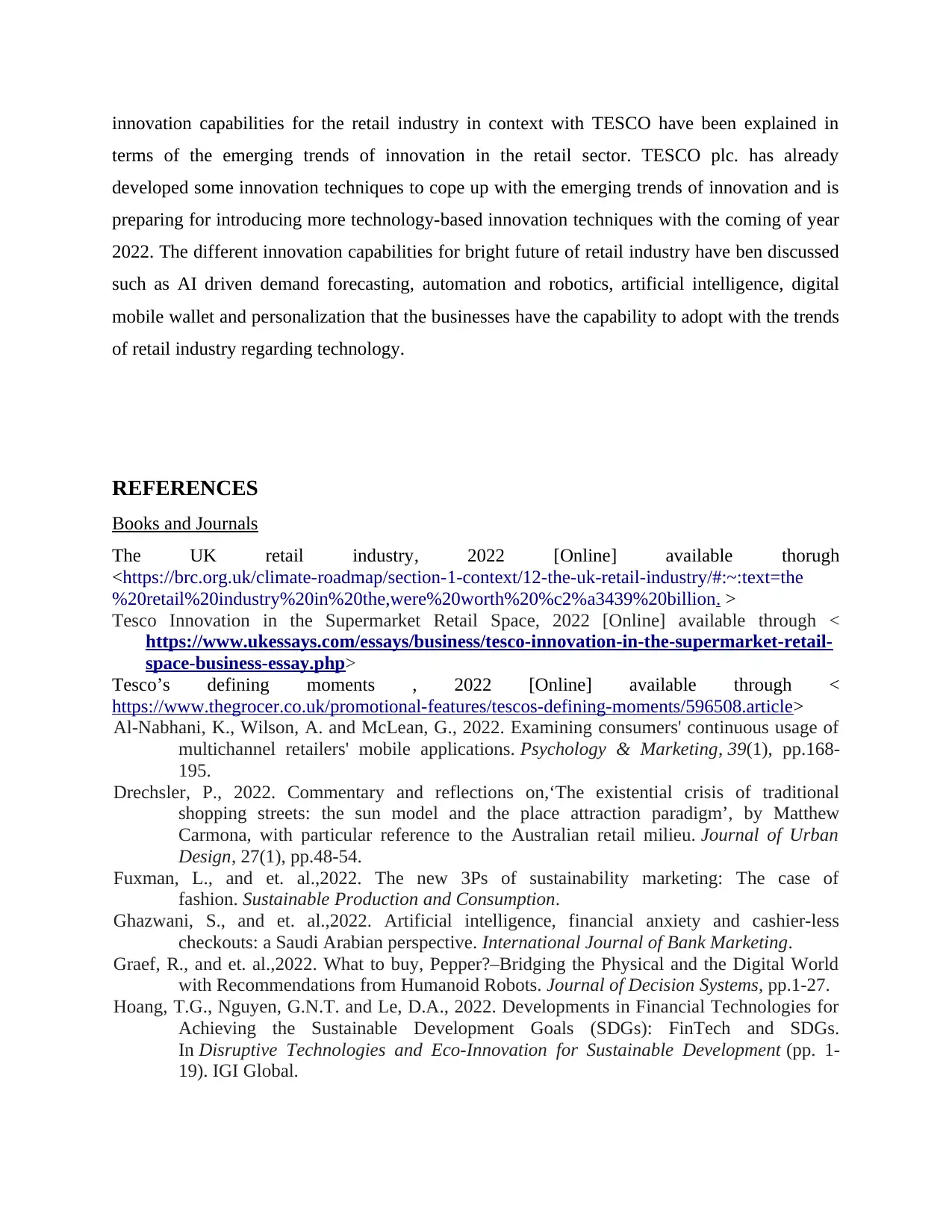
innovation capabilities for the retail industry in context with TESCO have been explained in
terms of the emerging trends of innovation in the retail sector. TESCO plc. has already
developed some innovation techniques to cope up with the emerging trends of innovation and is
preparing for introducing more technology-based innovation techniques with the coming of year
2022. The different innovation capabilities for bright future of retail industry have ben discussed
such as AI driven demand forecasting, automation and robotics, artificial intelligence, digital
mobile wallet and personalization that the businesses have the capability to adopt with the trends
of retail industry regarding technology.
REFERENCES
Books and Journals
The UK retail industry, 2022 [Online] available thorugh
<https://brc.org.uk/climate-roadmap/section-1-context/12-the-uk-retail-industry/#:~:text=the
%20retail%20industry%20in%20the,were%20worth%20%c2%a3439%20billion. >
Tesco Innovation in the Supermarket Retail Space, 2022 [Online] available through <
https://www.ukessays.com/essays/business/tesco-innovation-in-the-supermarket-retail-
space-business-essay.php>
Tesco’s defining moments , 2022 [Online] available through <
https://www.thegrocer.co.uk/promotional-features/tescos-defining-moments/596508.article>
Al‐Nabhani, K., Wilson, A. and McLean, G., 2022. Examining consumers' continuous usage of
multichannel retailers' mobile applications. Psychology & Marketing, 39(1), pp.168-
195.
Drechsler, P., 2022. Commentary and reflections on,‘The existential crisis of traditional
shopping streets: the sun model and the place attraction paradigm’, by Matthew
Carmona, with particular reference to the Australian retail milieu. Journal of Urban
Design, 27(1), pp.48-54.
Fuxman, L., and et. al.,2022. The new 3Ps of sustainability marketing: The case of
fashion. Sustainable Production and Consumption.
Ghazwani, S., and et. al.,2022. Artificial intelligence, financial anxiety and cashier-less
checkouts: a Saudi Arabian perspective. International Journal of Bank Marketing.
Graef, R., and et. al.,2022. What to buy, Pepper?–Bridging the Physical and the Digital World
with Recommendations from Humanoid Robots. Journal of Decision Systems, pp.1-27.
Hoang, T.G., Nguyen, G.N.T. and Le, D.A., 2022. Developments in Financial Technologies for
Achieving the Sustainable Development Goals (SDGs): FinTech and SDGs.
In Disruptive Technologies and Eco-Innovation for Sustainable Development (pp. 1-
19). IGI Global.
terms of the emerging trends of innovation in the retail sector. TESCO plc. has already
developed some innovation techniques to cope up with the emerging trends of innovation and is
preparing for introducing more technology-based innovation techniques with the coming of year
2022. The different innovation capabilities for bright future of retail industry have ben discussed
such as AI driven demand forecasting, automation and robotics, artificial intelligence, digital
mobile wallet and personalization that the businesses have the capability to adopt with the trends
of retail industry regarding technology.
REFERENCES
Books and Journals
The UK retail industry, 2022 [Online] available thorugh
<https://brc.org.uk/climate-roadmap/section-1-context/12-the-uk-retail-industry/#:~:text=the
%20retail%20industry%20in%20the,were%20worth%20%c2%a3439%20billion. >
Tesco Innovation in the Supermarket Retail Space, 2022 [Online] available through <
https://www.ukessays.com/essays/business/tesco-innovation-in-the-supermarket-retail-
space-business-essay.php>
Tesco’s defining moments , 2022 [Online] available through <
https://www.thegrocer.co.uk/promotional-features/tescos-defining-moments/596508.article>
Al‐Nabhani, K., Wilson, A. and McLean, G., 2022. Examining consumers' continuous usage of
multichannel retailers' mobile applications. Psychology & Marketing, 39(1), pp.168-
195.
Drechsler, P., 2022. Commentary and reflections on,‘The existential crisis of traditional
shopping streets: the sun model and the place attraction paradigm’, by Matthew
Carmona, with particular reference to the Australian retail milieu. Journal of Urban
Design, 27(1), pp.48-54.
Fuxman, L., and et. al.,2022. The new 3Ps of sustainability marketing: The case of
fashion. Sustainable Production and Consumption.
Ghazwani, S., and et. al.,2022. Artificial intelligence, financial anxiety and cashier-less
checkouts: a Saudi Arabian perspective. International Journal of Bank Marketing.
Graef, R., and et. al.,2022. What to buy, Pepper?–Bridging the Physical and the Digital World
with Recommendations from Humanoid Robots. Journal of Decision Systems, pp.1-27.
Hoang, T.G., Nguyen, G.N.T. and Le, D.A., 2022. Developments in Financial Technologies for
Achieving the Sustainable Development Goals (SDGs): FinTech and SDGs.
In Disruptive Technologies and Eco-Innovation for Sustainable Development (pp. 1-
19). IGI Global.
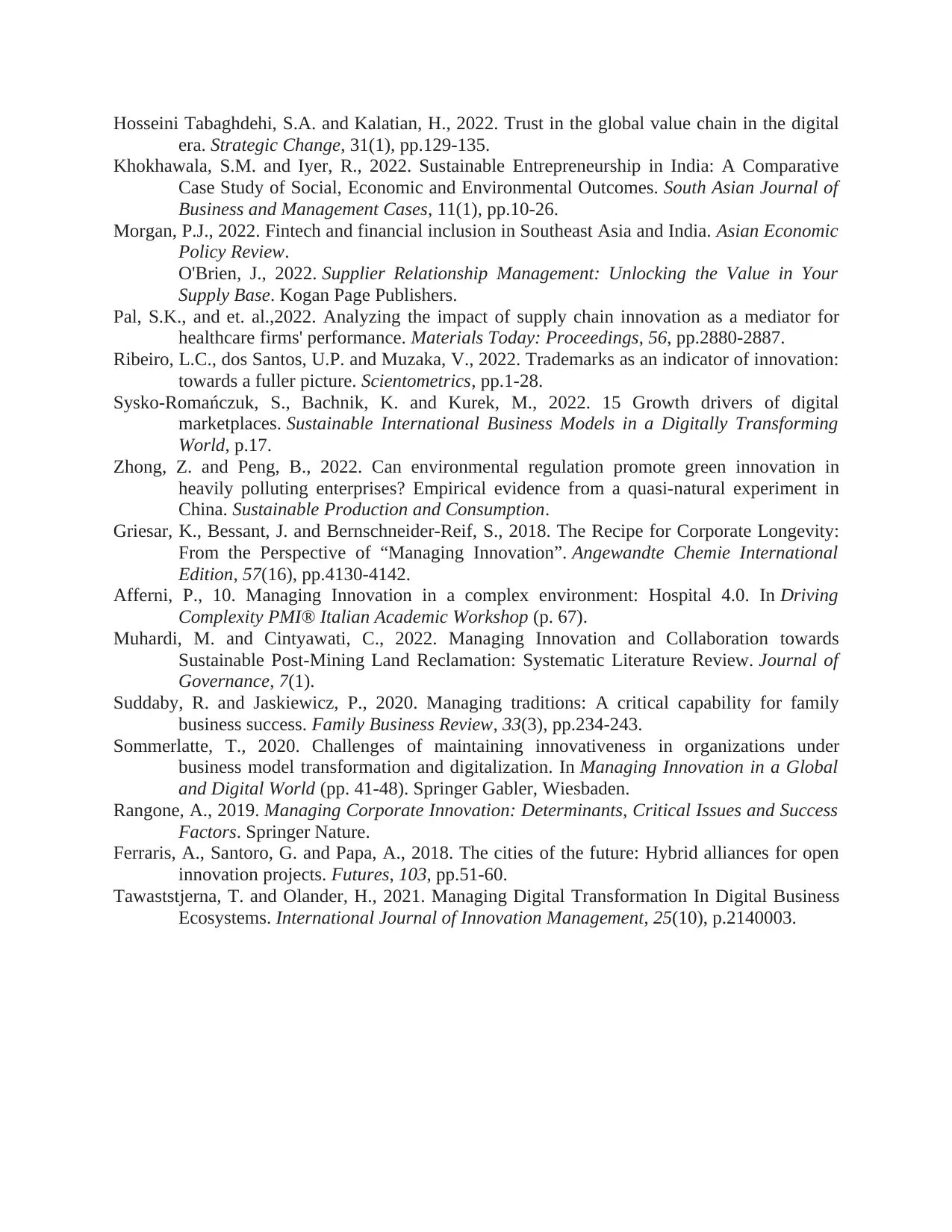
Hosseini Tabaghdehi, S.A. and Kalatian, H., 2022. Trust in the global value chain in the digital
era. Strategic Change, 31(1), pp.129-135.
Khokhawala, S.M. and Iyer, R., 2022. Sustainable Entrepreneurship in India: A Comparative
Case Study of Social, Economic and Environmental Outcomes. South Asian Journal of
Business and Management Cases, 11(1), pp.10-26.
Morgan, P.J., 2022. Fintech and financial inclusion in Southeast Asia and India. Asian Economic
Policy Review.
O'Brien, J., 2022. Supplier Relationship Management: Unlocking the Value in Your
Supply Base. Kogan Page Publishers.
Pal, S.K., and et. al.,2022. Analyzing the impact of supply chain innovation as a mediator for
healthcare firms' performance. Materials Today: Proceedings, 56, pp.2880-2887.
Ribeiro, L.C., dos Santos, U.P. and Muzaka, V., 2022. Trademarks as an indicator of innovation:
towards a fuller picture. Scientometrics, pp.1-28.
Sysko-Romańczuk, S., Bachnik, K. and Kurek, M., 2022. 15 Growth drivers of digital
marketplaces. Sustainable International Business Models in a Digitally Transforming
World, p.17.
Zhong, Z. and Peng, B., 2022. Can environmental regulation promote green innovation in
heavily polluting enterprises? Empirical evidence from a quasi-natural experiment in
China. Sustainable Production and Consumption.
Griesar, K., Bessant, J. and Bernschneider‐Reif, S., 2018. The Recipe for Corporate Longevity:
From the Perspective of “Managing Innovation”. Angewandte Chemie International
Edition, 57(16), pp.4130-4142.
Afferni, P., 10. Managing Innovation in a complex environment: Hospital 4.0. In Driving
Complexity PMI® Italian Academic Workshop (p. 67).
Muhardi, M. and Cintyawati, C., 2022. Managing Innovation and Collaboration towards
Sustainable Post-Mining Land Reclamation: Systematic Literature Review. Journal of
Governance, 7(1).
Suddaby, R. and Jaskiewicz, P., 2020. Managing traditions: A critical capability for family
business success. Family Business Review, 33(3), pp.234-243.
Sommerlatte, T., 2020. Challenges of maintaining innovativeness in organizations under
business model transformation and digitalization. In Managing Innovation in a Global
and Digital World (pp. 41-48). Springer Gabler, Wiesbaden.
Rangone, A., 2019. Managing Corporate Innovation: Determinants, Critical Issues and Success
Factors. Springer Nature.
Ferraris, A., Santoro, G. and Papa, A., 2018. The cities of the future: Hybrid alliances for open
innovation projects. Futures, 103, pp.51-60.
Tawaststjerna, T. and Olander, H., 2021. Managing Digital Transformation In Digital Business
Ecosystems. International Journal of Innovation Management, 25(10), p.2140003.
era. Strategic Change, 31(1), pp.129-135.
Khokhawala, S.M. and Iyer, R., 2022. Sustainable Entrepreneurship in India: A Comparative
Case Study of Social, Economic and Environmental Outcomes. South Asian Journal of
Business and Management Cases, 11(1), pp.10-26.
Morgan, P.J., 2022. Fintech and financial inclusion in Southeast Asia and India. Asian Economic
Policy Review.
O'Brien, J., 2022. Supplier Relationship Management: Unlocking the Value in Your
Supply Base. Kogan Page Publishers.
Pal, S.K., and et. al.,2022. Analyzing the impact of supply chain innovation as a mediator for
healthcare firms' performance. Materials Today: Proceedings, 56, pp.2880-2887.
Ribeiro, L.C., dos Santos, U.P. and Muzaka, V., 2022. Trademarks as an indicator of innovation:
towards a fuller picture. Scientometrics, pp.1-28.
Sysko-Romańczuk, S., Bachnik, K. and Kurek, M., 2022. 15 Growth drivers of digital
marketplaces. Sustainable International Business Models in a Digitally Transforming
World, p.17.
Zhong, Z. and Peng, B., 2022. Can environmental regulation promote green innovation in
heavily polluting enterprises? Empirical evidence from a quasi-natural experiment in
China. Sustainable Production and Consumption.
Griesar, K., Bessant, J. and Bernschneider‐Reif, S., 2018. The Recipe for Corporate Longevity:
From the Perspective of “Managing Innovation”. Angewandte Chemie International
Edition, 57(16), pp.4130-4142.
Afferni, P., 10. Managing Innovation in a complex environment: Hospital 4.0. In Driving
Complexity PMI® Italian Academic Workshop (p. 67).
Muhardi, M. and Cintyawati, C., 2022. Managing Innovation and Collaboration towards
Sustainable Post-Mining Land Reclamation: Systematic Literature Review. Journal of
Governance, 7(1).
Suddaby, R. and Jaskiewicz, P., 2020. Managing traditions: A critical capability for family
business success. Family Business Review, 33(3), pp.234-243.
Sommerlatte, T., 2020. Challenges of maintaining innovativeness in organizations under
business model transformation and digitalization. In Managing Innovation in a Global
and Digital World (pp. 41-48). Springer Gabler, Wiesbaden.
Rangone, A., 2019. Managing Corporate Innovation: Determinants, Critical Issues and Success
Factors. Springer Nature.
Ferraris, A., Santoro, G. and Papa, A., 2018. The cities of the future: Hybrid alliances for open
innovation projects. Futures, 103, pp.51-60.
Tawaststjerna, T. and Olander, H., 2021. Managing Digital Transformation In Digital Business
Ecosystems. International Journal of Innovation Management, 25(10), p.2140003.
1 out of 15
Related Documents
Your All-in-One AI-Powered Toolkit for Academic Success.
+13062052269
info@desklib.com
Available 24*7 on WhatsApp / Email
![[object Object]](/_next/static/media/star-bottom.7253800d.svg)
Unlock your academic potential
© 2024 | Zucol Services PVT LTD | All rights reserved.





